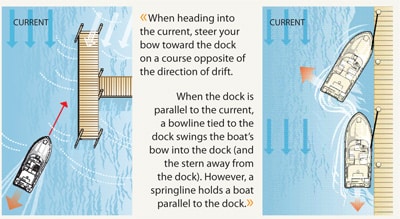
Strong winds complicate any docking maneuver, and boaters in rivers or coastal areas might have to add current into the equation. For the unprepared, high winds and fast-moving water can create embarrassing situations and the potential for damage to the boat or dock. Once you understand the effects the wind and current have on your boat, you can formulate a docking plan. Then, it’s just a matter of being patient and staying in control.
Assess Before You Commit
Instead of just heading for the dock and hoping for the best, spend a few moments observing the strength and direction of the wind and current. Most often, the water will be moving parallel to shore — and therefore to the dock — but eddies or a crosswind might move your boat in unexpected directions. Pause in open water, safely away from the dock and other boats, and observe your speed and direction of drift.
Steer Opposite of the Direction of Drift
Keep the bow headed into the current and use small throttle adjustments to move forward at a controlled speed. Most boats have better steering and throttle response in forward than reverse, and you will have a better view of the landing area when looking forward instead of over your shoulder.
Make Small Steering and Throttle Corrections
Use just enough throttle to move forward slowly, and if you need to shift to one side or the other, use small steering adjustments and wait for them to take effect before feeding in more. Big turns can cause the current or wind to catch the bow and swing the boat sideways into an uncontrollable arc.
Have the Lines Ready
A perfectly executed approach won’t count for much if your crew fumbles the dock lines when you get there. When tying to a dock that’s parallel to the current or directly into the wind, use the spring cleat amidships to let the current pull the boat parallel to the dock.









